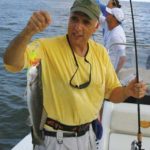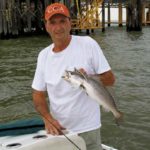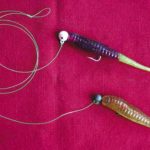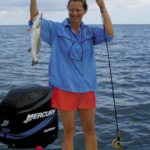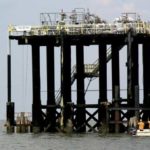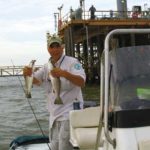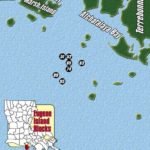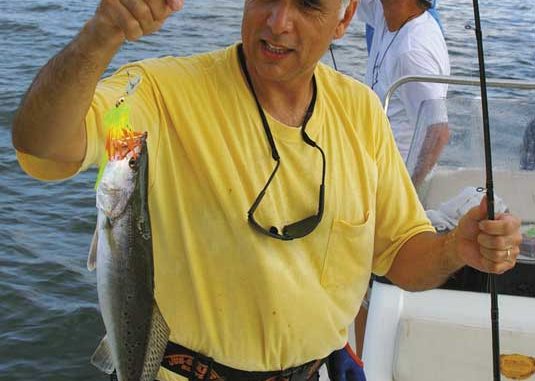
The numbers on these Eugene Island rigs often match those in your ice chest this time of year.
Like a hyperactive schoolboy at recess, 66-year-old Danny Womack positioned his bay boat stern end to the rig, while instructing me to drop the anchor.
Before I could get my tackle box lid open to grab a 3/8-ounce jig head and plastic bait, Womack was chunking his into the emerald-green water below the platform.
“Just get it somewhere in the Gulf behind the boat,” he said, ignoring the painstaking efforts I was making trying to gear up with fish flopping around on the deck at my feet.
Nor was he waiting around for such foolishness. He was no less than six or seven trout up on me before I made my first cast.
There are no names when fishing the offshore rigs out of sight of the Central Louisiana coastline for specks. There are simply numbers that remind you of those called out in a game of bingo at some fundraiser.
Numbers like 51, 52, 63, 65, 74, 89 and 95 are all noteworthy platforms, whose locations summertime anglers can pretty much cash in on when the conditions are right.
Marty Scelfo, 55, owner of Scelfo’s Sporting & Marine in Franklin, claims when he was a youngster, the fishing at one of those rigs in the Eugene Island blocks spoiled him.
“I thought my dad was going to die at block 51,” he said.
“He almost ruined me out there. I was a kid then and as long as I can remember, he believed in that platform. And, actually, two of the best ones that were out there were 51B and 51C, but they have since been picked up.”
The one thing saltwater anglers who venture out to the Eugene Island rigs will notice is seldom do you have to pull out a tape measure to check the size.
“Normally, the fish you catch out on the rigs are better than what you’ll catch along the bank,” Scelfo said. “When I started out, you governed your trip on how nice the fish you caught were. You also might have had two ice chests full. There was no limit then, of course, but if you had that, you had a pretty good trip.”
On the trip with Womack out to the Eugene Island block rigs, I certainly would have to agree with Scelfo, but also have to describe it as better than a “pretty good trip.”
I finally overcame my slothful preparation and tossed my artificial bait in the Gulf behind the boat. He and I proceeded to catch our limits, hooking fish with nearly every cast.
In fact, so much so that my partner broke out a fly rod, which is not to say that’s the norm. On the contrary, it only reflects the potential of rig fishing combined with good fortune and implementing tactics developed through many years of fishing the platforms.
Womack considers what we experienced as “catching days” and not “fishing days.” The difference being that one takes virtually no effort and the other minimal to maximum effort.
Several weeks following our trip, we were on another in the Eugene Island blocks. This time, both of our wives accompanied us. After probing and “fishing” one rig to no avail, we experienced “catching” at another. Womack’s wife Denise made the jesting proclamation that it took absolutely no skill catching the specks the way we were, much to his chagrin.
Yet there are keys to being successful when rig fishing for specks. Womack’s 30-plus years fishing Eugene Island have provided him with basic fundamentals that help him put fish in the boat — water condition being one.
“I guess the simplest thing is to make sure the water is clear and salty,” he said. “When you’re leaving the landing, blocks 51 and 52 are the logical points because they’re further west away from the river, and you’re more apt to find clear, salty water. You can see the water change in your boat wake where it starts to foam. That fresh water will run over the salty water. Sometimes in shallow areas you can catch them, but the rule is you’ll catch them in clear, salty water.”
En route offshore to the various rigs in Eugene Island, it’s not uncommon to actually see tides crisscrossing the open Gulf waters. Moreover, how you fish the tides flowing through and around the platforms plays an important role.
“You’ll cross a bunch of tides,” Womack said. “One is going this way and another is going that way. You’ll see grass built up forming grass lines, and it’ll change out there. I like to pull up to a rig and go with the current just drifting, casting into the rig, looking for fish — unless you pick something up; then you’ll anchor. If you don’t, then you go to the other side, tie up and fish with the tide, where you throw behind the boat with the current or fish around the boat with the current. They are going to be facing into that current one way or another where you can catch them.”
The strength of the current will impact how deep your bait will go down to where the fish are.
“If the current is too strong and you’re anchored out away from the rig and cast behind the boat, it raises your bait up, which is the reason you don’t find them sometimes,” Womack said.
To compensate, Womack uses a double hook set-up with a 1/2-ounce jig head on the bottom and a 1/4-ounce jig on top, both with 4-inch plastic H&H Cocahoes, Deadly Dudleys or Stanley Wedge Tail saltwater baits.
“First of all, you’ve got to let your line out, get (the lures) as deep as you can and just work them up,” he said. “You’ll find those fish somewhere in that area. When the current is really strong they continually hit that trailing bait. Sometimes it’s just too strong and your baits are going to be laying somewhere from the bottom up, but you typically want them to go to the bottom to start. If they are schooling down there, they’ll hit when the baits are going down. So, let them go down and work them back to you.”
Another key Womack mentions is the need to keep baits in the water once the fish get stirred up and you’ve gotten them into a feeding frenzy.
“Typically, if you have two, three or four people, you have a better chance of getting them started. The more fish you have on, the better it gets,” Womack said.
One thing for sure and most will agree, regardless of the type of fishing you do, bigger fish tend to be located closer to the bottom. Rig fishing is no different, in that fish can be stratified in 8, 10 or 12 feet of water. Whatever the optimum level is, where bait is located, specks will be there as well.
“If you have the patience to work it and put on a heavier weight, you’ll typically catch a little bigger fish,” Womack said. “I don’t catch a lot of big fish, but a 5-pound fish would, typically, be about the biggest in the area.”
Eugene Island is sometimes influenced by high water from the Atchafalaya River.
“When you’ve got a good crawfish season, you get a weak saltwater season because of the fresh water,” Scelfo said. “It just simply means it runs later. They’ve still got fish out there; you just have to go further out to get them. You might have to go to blocks 89 and 95 instead of 51, which are 20 to 30 minutes past it. High water is a seasonal thing, and you never know if you’re going to have a good shrimp season or a good crawfish season. But if you have a good shrimp season, you’re going to have fish.”
Scelfo points out that there is a natural westerly progression when fishing the rigs as anglers move into the later summer months.
“The fish migrate from east to west,” he said. “It always starts back of Cocodrie and runs toward Fresh Water Bayou, where you’ll start catching fish. You’ll catch them well into September and sometimes October, depending on how many early cold fronts come through that eventually push them out of the shallow water.”
One of the best rigs to fish in the central Gulf, Womack says, is 74.
“The premier rig out there is 74, and the reason for that is when you’re riding from 51 and 52, you’re going from 18 to 24 feet of water to shallower depths,” he said. “You can see it coming up. You’ll start to see the Gulf rise to the Chevron platform, which is in about 14 feet of water, and it’s on a shelf. It’s a wonderful reef out there. In the same trips, you’ll catch redfish. One day I was out there, and the water was real clear. I caught king mackerel and jack crevalle while trout fishing. It’s a pretty special place.”
The uniqueness of Eugene Island is, perhaps, what exists below the surface as there are reefs located throughout the region. The reefs are charted, and many trout anglers GPS their locations and fish them.
However, it’s the rigs that get most of the attention in the Eugene Island blocks. The sub-sea beds the platforms are built on are teeming with bio-life that creates a perfect habitat for these prized fish.
The biggest change from years of fishing Eugene Island, both Womack and Scelfo concur, is the increase in the number of boats fishing the region.
“Years ago, you only had a handful of people who went out there and fished the rigs, and most people fished only during the day,” Scelfo said. “Now they fish 24/7. Of course with the price of gas what it is, it’s probably going to change back around.”
Like a bingo game calling out numbers, be sure to listen closely. When the numbers 51, 52, 63, 65, 74, 89 and 95 come up, it’s not your card but your ice chest that will be full.
